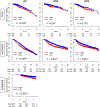High RAD51 gene expression is associated with aggressive biology and with poor survival in breast cancer
- PMID: 35249172
- PMCID: PMC8995390
- DOI: 10.1007/s10549-022-06552-0
High RAD51 gene expression is associated with aggressive biology and with poor survival in breast cancer
Abstract
Purpose: Although the DNA repair mechanism is important in preventing carcinogenesis, its activation in established cancer cells may support their proliferation and aggravate cancer progression. RAD51 cooperates with BRCA2 and is essential in the homologous recombination of DNA repair. To this end, we hypothesized that RAD51 gene expression is associated with cancer cell proliferation and poor prognosis of breast cancer (BC) patients.
Methods: A total of 8515 primary BC patients with transcriptome and clinical data from 17 independent cohorts were analyzed. The median value was used to divide each cohort into high and low RAD51 expression groups.
Results: High RAD51 expression enriched the DNA repair gene set and was correlated with DNA repair-related genes. Nottingham histological grade, Ki67 expression and cell proliferation-related gene sets (E2F Targets, G2M Checkpoint and Myc Targets) were all significantly associated with the high RAD51 BC group. RAD51 expression was positively correlated with Homologous Recombination Deficiency, as well as both mutational burden and neoantigens that accompanied a higher infiltration of immune cells. Primary BC with lymph node metastases was associated with high expression of RAD51 in two cohorts. There was no strong correlation between RAD51 expression and drug sensitivity in cell lines, and RAD51 expression was lower after the neoadjuvant chemotherapy compared to before the treatment. High RAD51 BC was associated with poor prognosis consistently in three independent cohorts.
Conclusion: RAD51 gene expression is associated with aggressive cancer biology, cancer cell proliferation, and poor survival in breast cancer.
Keywords: BRCA; Breast cancer; DNA repair; HRD; Neoadjuvant chemotherapy; RAD51.
© 2022. The Author(s), under exclusive licence to Springer Science+Business Media, LLC, part of Springer Nature.
Conflict of interest statement
Conflict of interest
No conflicts of interest to disclose.
Figures







Similar articles
-
RAD51 High-Expressed Hepatocellular Carcinomas Are Associated With High Cell Proliferation.J Surg Res. 2024 Oct;302:250-258. doi: 10.1016/j.jss.2024.07.046. Epub 2024 Aug 6. J Surg Res. 2024. PMID: 39111128
-
Clinical and biological significance of RAD51 expression in breast cancer: a key DNA damage response protein.Breast Cancer Res Treat. 2016 Aug;159(1):41-53. doi: 10.1007/s10549-016-3915-8. Epub 2016 Jul 27. Breast Cancer Res Treat. 2016. PMID: 27464795
-
Effective targeting of breast cancer stem cells by combined inhibition of Sam68 and Rad51.Oncogene. 2022 Apr;41(15):2196-2209. doi: 10.1038/s41388-022-02239-4. Epub 2022 Feb 25. Oncogene. 2022. PMID: 35217791 Free PMC article.
-
RAD51 as a potential surrogate marker for DNA repair capacity in solid malignancies.Int J Cancer. 2017 Oct 1;141(7):1286-1294. doi: 10.1002/ijc.30764. Epub 2017 May 19. Int J Cancer. 2017. PMID: 28477336 Review.
-
BRCA2: one small step for DNA repair, one giant protein purified.Yale J Biol Med. 2013 Dec 13;86(4):479-89. Yale J Biol Med. 2013. PMID: 24348212 Free PMC article. Review.
Cited by
-
Polymorphisms of DNA Repair Genes in Thyroid Cancer.Int J Mol Sci. 2024 May 30;25(11):5995. doi: 10.3390/ijms25115995. Int J Mol Sci. 2024. PMID: 38892180 Free PMC article. Review.
-
Evaluating dynamic contrast-enhanced MRI for differentiating HER2-zero, HER2-low, and HER2-positive breast cancers in patients undergoing neoadjuvant chemotherapy.Eur J Med Res. 2025 Feb 25;30(1):132. doi: 10.1186/s40001-024-02188-6. Eur J Med Res. 2025. PMID: 40001120 Free PMC article.
-
CD133 expression is associated with less DNA repair, better response to chemotherapy and survival in ER-positive/HER2-negative breast cancer.Breast Cancer Res Treat. 2024 Nov;208(2):415-427. doi: 10.1007/s10549-024-07434-3. Epub 2024 Jul 17. Breast Cancer Res Treat. 2024. PMID: 39017815 Free PMC article.
-
NBN, RAD51 and XRCC3 Polymorphisms as Potential Predictive Biomarkers of Adjuvant Radiotherapy Toxicity in Early HER2-Positive Breast Cancer.Cancers (Basel). 2022 Sep 8;14(18):4365. doi: 10.3390/cancers14184365. Cancers (Basel). 2022. PMID: 36139526 Free PMC article.
-
CD133 expression is associated with less DNA repair, better response to chemotherapy and survival in ER-positive/HER2-negative breast cancer.Res Sq [Preprint]. 2024 Mar 27:rs.3.rs-4148608. doi: 10.21203/rs.3.rs-4148608/v1. Res Sq. 2024. Update in: Breast Cancer Res Treat. 2024 Nov;208(2):415-427. doi: 10.1007/s10549-024-07434-3. PMID: 38585981 Free PMC article. Updated. Preprint.
References
-
- Teraoka S, Muguruma M, Takano N, Miyahara K, Kawate T, Kaise H, Yamada K, Miyazawa K, Ishikawa T (2020) Association of BRCA Mutations and BRCAness Status With Anticancer Drug Sensitivities in Triple-Negative Breast Cancer Cell Lines. J Surg Res 250:200–208. doi: 10.1016/j.jss.2019.12.040 - DOI - PubMed
MeSH terms
Substances
Grants and funding
- R37 CA248018/CA/NCI NIH HHS/United States
- P30 CA016056/CA/NCI NIH HHS/United States
- W81XWH-19-1-0674/U.S. Department of Defense
- R37CA248018/Foundation for the National Institutes of Health
- R01 CA251545/CA/NCI NIH HHS/United States
- R01 CA250412/CA/NCI NIH HHS/United States
- W81XWH-19-1-0111/U.S. Department of Defense
- R01 EB029596/EB/NIBIB NIH HHS/United States
- P30CA016056/Roswell Park Cancer Institute
- R01EB029596/Foundation for the National Institutes of Health
- R01CA250412/Foundation for the National Institutes of Health
- R01CA251545/Foundation for the National Institutes of Health
LinkOut - more resources
Full Text Sources
Medical
Research Materials
Miscellaneous

